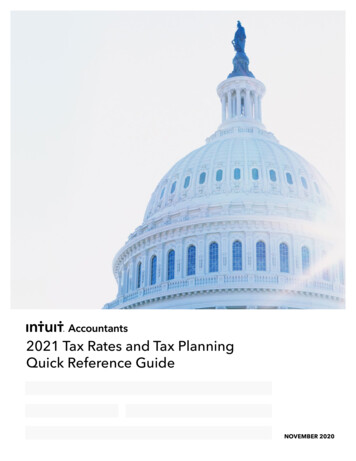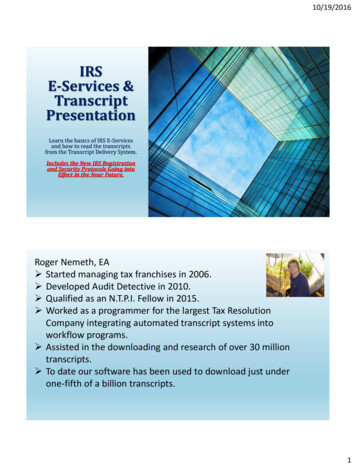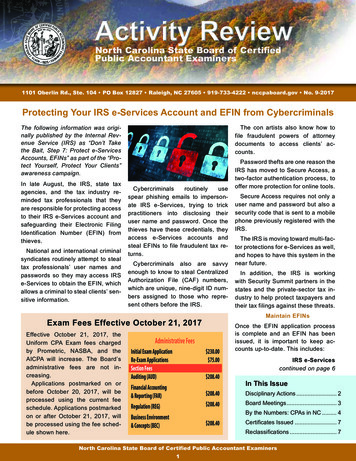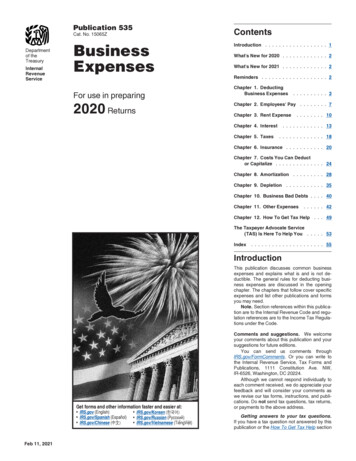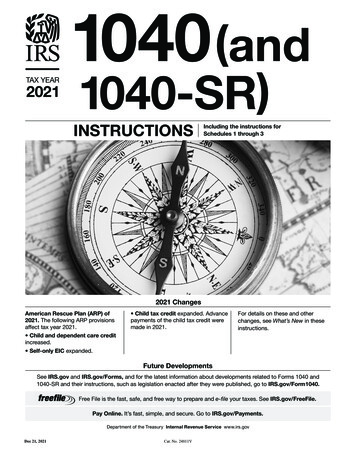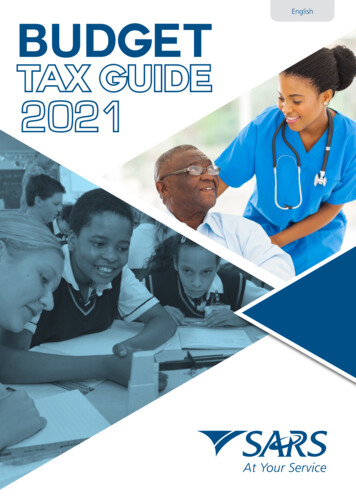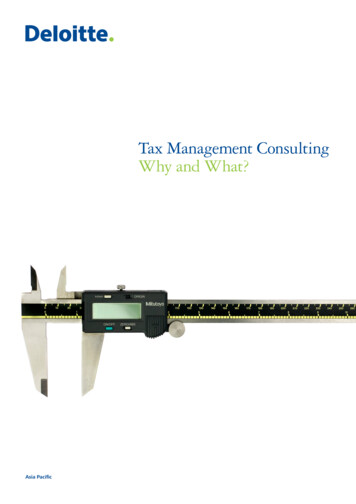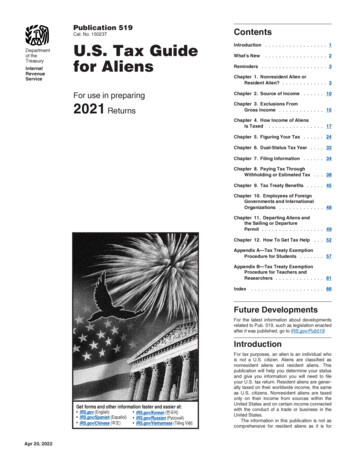
Transcription
Publication 519ContentsU.S. Tax Guidefor AliensIntroduction . . . . . . . . . . . . . . . . . . 1Cat. No. 15023TDepartmentof theTreasuryInternalRevenueServiceFor use in preparing2021 ReturnsWhat's New. 2Reminders . . . . . . . . . . . . . . . . . . . 3Chapter 1. Nonresident Alien orResident Alien? . . . . . . . . . . . . . 3Chapter 2. Source of Income . . . . . . 10Chapter 3. Exclusions FromGross Income . . . . . . . . . . . . . 15Chapter 4. How Income of AliensIs Taxed . . . . . . . . . . . . . . . . 17Chapter 5. Figuring Your Tax . . . . . . 24Chapter 6. Dual-Status Tax Year . . . . 32Chapter 7. Filing Information . . . . . . 34Chapter 8. Paying Tax ThroughWithholding or Estimated Tax . . . 38Chapter 9. Tax Treaty Benefits . . . . . 45Chapter 10. Employees of ForeignGovernments and InternationalOrganizations . . . . . . . . . . . . . 48Chapter 11. Departing Aliens andthe Sailing or DeparturePermit . . . . . . . . . . . . . . . . . . 49Chapter 12. How To Get Tax Help . . . 52Appendix A—Tax Treaty ExemptionProcedure for Students . . . . . . . 57Appendix B—Tax Treaty ExemptionProcedure for Teachers andResearchers . . . . . . . . . . . . . . 61Index. . . . . . . . . . . . . . . . . . . . . 66Future DevelopmentsFor the latest information about developmentsrelated to Pub. 519, such as legislation enactedafter it was published, go to IRS.gov/Pub519.IntroductionGet forms and other information faster and easier at: IRS.gov (English) IRS.gov/Spanish (Español) IRS.gov/Chinese (中文)Apr 20, 2022 IRS.gov/Korean (한국어) IRS.gov/Russian (Pусский) IRS.gov/Vietnamese (Tiếng Việt)For tax purposes, an alien is an individual whois not a U.S. citizen. Aliens are classified asnonresident aliens and resident aliens. Thispublication will help you determine your statusand give you information you will need to fileyour U.S. tax return. Resident aliens are generally taxed on their worldwide income, the sameas U.S. citizens. Nonresident aliens are taxedonly on their income from sources within theUnited States and on certain income connectedwith the conduct of a trade or business in theUnited States.The information in this publication is not ascomprehensive for resident aliens as it is for
Table A. Where To Find What You Need To Know About U.S. TaxesCommonly Asked QuestionsAm I a nonresident alien or resident alien?Where To Find the AnswerSee chapter 1.Can I be a nonresident alien and a resident alien in the sameyear? See Dual-Status Aliens in chapter 1. See chapter 6.I am a resident alien and my spouse is a nonresident alien. Arethere special rules for us? See Nonresident Spouse Treated as a Residentin chapter 1. See Community Income in chapter 2.Is all my income subject to U.S. tax? See chapter 2. See chapter 3.Is my scholarship subject to U.S. tax? See Scholarships, Grants, Prizes, and Awards in chapter 2. See Scholarships and Fellowship Grants in chapter 3. See chapter 9.Would any U.S. estate or gift taxes apply to me, my estate, or an See U.S. federal estate and gift tax in Reminders.estate for which I am an executor, trustee, or representative?What is the tax rate on my income subject to U.S. tax?See chapter 4.I moved to the United States this year. Can I deduct my movingexpenses on my U.S. return?See Deductions in chapter 5.Can I claim my spouse and/or children as dependents?See Dependents in chapter 5.I pay income taxes to my home country. Can I get credit forthese taxes on my U.S. tax return?See Tax Credits and Payments in chapter 5.What forms must I file and when and where do I file them?See chapter 7.How should I pay my U.S. income taxes?See chapter 8.Am I eligible for any benefits under a tax treaty?Are employees of foreign governments and internationalorganizations exempt from U.S. tax?Is there anything special I have to do before leaving the UnitedStates?nonresident aliens. Resident aliens are generally treated the same as U.S. citizens and canfind more information in other IRS publicationsat IRS.gov/Forms.Table A provides a list of questions and thechapter or chapters in this publication whereyou will find the related discussion.Answers to frequently asked questions arepresented in the back of the publication.Comments and suggestions. We welcomeyour comments about this publication and suggestions for future editions.You can send us comments throughIRS.gov/FormComments. Or, you can write tothe Internal Revenue Service, Tax Forms andPublications, 1111 Constitution Ave. NW,IR-6526, Washington, DC 20224.Although we can’t respond individually toeach comment received, we do appreciate yourfeedback and will consider your comments andsuggestions as we revise our tax forms, instructions, and publications. Do not send tax questions, tax returns, or payments to the above address.Page 2 See Income Entitled to Tax Treaty Benefits in chapter 8. See chapter 9.See chapter 10. See Expatriation Tax in chapter 4. See chapter 11.Getting answers to your tax questions.If you have a tax question not answered by thispublication or the How To Get Tax Help sectionat the end of this publication, go to the IRS Interactive Tax Assistant page at IRS.gov/Help/ITA where you can find topics by using thesearch feature or viewing the categories listed.Getting tax forms, instructions, and publications. Go to IRS.gov/Forms to downloadcurrent and prior-year forms, instructions, andpublications.Ordering tax forms, instructions, andpublications. Go to IRS.gov/OrderForms toorder current forms, instructions, and publications; call 800-829-3676 to order prior-yearforms and instructions. The IRS will processyour order for forms and publications as soonas possible. Do not resubmit requests you’vealready sent us. You can get forms and publications faster online.What's NewCredits for sick and family leave for certainself-employed individuals. The Families FirstCoronavirus Response Act (FFCRA) helpedself-employed individuals affected by coronavirus by providing paid sick leave and paid familyleave credits equivalent to those that employersare required to provide their employees forqualified sick leave wages and qualified familyleave wages. The COVID-related Tax Relief Actof 2020 extended the period during whichself-employed individuals can claim these credits from April 1, 2020, through March 31, 2021.For more information, see IRS.gov/COVID-19Related-Tax-Credits.Extension and expansion of credits for sickand family leave. The American Rescue PlanAct of 2021 (the ARP), enacted on March 11,2021, provides that certain self-employed individuals can claim credits for up to 10 days of“paid sick leave,” and up to 60 days of “paidPublication 519 (2021)
family leave,” if they are unable to work or telework due to circumstances related to coronavirus. Self-employed individuals may claim thesecredits for the period beginning on April 1,2021, and ending September 30, 2021. Formore information, see Form 7202 and its instructions.COVID-19 Medical Condition Travel Exception. For tax year 2021, individuals cannotclaim the COVID-19 Medical Condition TravelException to exclude any days of presence inthe United States for the purpose of the “substantial presence test.” However, days of presence in the United States in 2020 that were excluded for tax year 2020 may impact theapplication of the “substantial presence test” fortax year 2021. For more information, see Substantial Presence Test, later. Also, see 0-20 IRB#REVPROC-2020-20, and the instructions for Forms8843 and 8233.RemindersCharitable contributions. Students or business apprentices eligible for the benefits of Article 21(2) of the United States-India Income TaxTreaty who have elected to use the standarddeduction may qualify to take a deduction forcharitable contributions of up to 300. For moreinformation, see chapter 5.Form 1040-NR-EZ discontinued. Beginningwith tax year 2020, Form 1040-NR-EZ is no longer available. Nonresident alien taxpayersshould use Form 1040-NR.Redesigned Form 1040-NR. Beginning withtax year 2020, nonresident alien taxpayers willfile a redesigned Form 1040-NR, which is similar to the Form 1040. Attach Form 1040-NRSchedules OI, A, and NEC to Form 1040-NR asnecessary. Filers may also be required to attachForm 1040 Schedules 1, 2, or 3 to Form1040-NR. For more information, see Form1040-NR and its instructions.Disaster tax relief. Disaster tax relief is available for those impacted by certain Presidentiallydeclared disasters in 2021 (see IRS.gov/DisasterTaxRelief). Aliens who are required tofile a U.S. income tax return may be affected.For more information, see the Instructions forForm 1040, or the Instructions for Form1040-NR.Multilevel marketing. For clarification regarding the characterization and source of incomereceived from multilevel marketing companiesby distributors (upper-tier distributors) that arebased on the sales or purchases of personswhom they have recruited and sponsored(lower-tier distributors), see Multilevel marketing under Personal Services in chapter 2.Additional Medicare Tax. You may be required to pay Additional Medicare Tax. Also,you may need to report Additional MedicareTax withheld by your employer. For more information, see Additional Medicare Tax under Social Security and Medicare Taxes and Self-Employment Tax in chapter 8. For moreinformation on Additional Medicare Tax, go toIRS.gov/ADMT.Premium tax credit. You may be eligible toclaim the premium tax credit if you, yourspouse, or a dependent enrolled in health insurance through the Health Insurance Marketplace(Marketplace). See Form 8962 and its instructions for more information.Advance payments of the premium taxcredit. Advance payments of the premium taxcredit may have been made to the health insurer to help pay for the insurance coverage ofyou, your spouse, or your dependent. If advance payments of the premium tax credit weremade, you must file a 2021 tax return and Form8962. If you enrolled someone who is notclaimed as a dependent on your tax return or formore information, see the Instructions for Form8962.Form 1095-A. If you, your spouse, or a dependent enrolled in health insurance throughthe Marketplace, you should have received aForm 1095-A. If you receive a Form 1095-A for2021, save it. It will help you figure your premium tax credit. If you did not receive a Form1095-A, contact the Marketplace.U.S. federal estate and gift tax. An individual (or deceased person) who is (or was) a nonresident noncitizen of the United States for estate and gift tax purposes may still have U.S.estate and gift tax filing and payment obligations. The determination of whether an individual is a nonresident noncitizen for U.S. estateand gift tax purposes is different than the determination of whether an individual is a nonresident alien for U.S. federal income tax purposes.Estate and gift tax considerations are outside ofthe scope of this publication, but you shouldconsult with the information available onIRS.gov to determine whether any U.S. estateor gift tax considerations may apply to your situation. Further information on U.S. federal estate tax considerations for nonresident noncitizens is available at Estate Tax for Nonresidentsnot Citizens of the United States and FrequentlyAsked Questions on Estate Taxes forNonresidents not Citizens of the United States.Further information on U.S. federal gift tax considerations for nonresidents noncitizens of theUnited States is available at Gift Tax forNonresidents not Citizens of the United Statesand Frequently Asked Questions on Gift Taxesfor Nonresidents not Citizens of the UnitedStates.Refunds of certain withholding tax delayed.Refund requests for tax withheld and reportedon Form 1042-S, Form 8288-A, or Form 8805may require additional time for processing. Allow up to 6 months for these refunds to be issued.Third-party designee. You can check the“Yes” box in the “Third-Party Designee” area ofyour return to authorize the IRS to discuss yourreturn with a friend, a family member, or anyother person you choose. This allows the IRS tocall the person you identified as your designeeto answer any questions that may arise duringthe processing of your return. It also allows yourdesignee to perform certain actions such asasking the IRS for copies of notices or transcripts related to your return. Also, the authorization can be revoked. See your income tax return instructions for details.Change of address. If you change your mailing address, be sure to notify the IRS usingForm 8822.Chapter 1Photographs of missing children. The IRS isa proud partner with the National Center forMissing & Exploited Children (NCMEC). Photographs of missing children selected by theCenter may appear in this publication on pagesthat would otherwise be blank. You can helpbring these children home by looking at thephotographs and calling 1-800-THE-LOST(1-800-843-5678) if you recognize a child.1.NonresidentAlien orResident Alien?IntroductionYou should first determine whether, for incometax purposes, you are a nonresident alien or aresident alien.If you are both a nonresident and resident inthe same year, you have a dual status. SeeDual-Status Aliens, later. Also see NonresidentSpouse Treated as a Resident and some otherspecial situations explained later in the chapter.TopicsThis chapter discusses: How to determine if you are a nonresident,resident, or dual-status alien; and How to treat a nonresident spouse as aresident alien.Useful ItemsYou may want to see:Form (and Instructions)1040 U.S. Individual Income Tax Return10401040-SR U.S. Tax Return for Seniors1040-SR1040-NR U.S. Nonresident Alien IncomeTax Return1040-NR8833 Treaty-Based Return PositionDisclosure Under Section 6114 or7701(b)88338840 Closer Connection ExceptionStatement for Aliens88408843 Statement for Exempt Individualsand Individuals With a MedicalCondition8843See chapter 12 for information about gettingthese forms.Nonresident AliensIf you are an alien (not a U.S. citizen), you areconsidered a nonresident alien unless you meetNonresident Alien or Resident Alien?Page 3
one of the two tests described under ResidentAliens below.Resident AliensYou are a resident alien of the United States fortax purposes if you meet either the green cardtest or the substantial presence test for calendar year 2021 (January 1–December 31). Evenif you do not meet either of these tests, you maybe able to choose to be treated as a U.S. resident for part of the year. See First-Year Choiceunder Dual-Status Aliens, later.Green Card TestYou are a resident for tax purposes if you are alawful permanent resident of the United Statesat any time during calendar year 2021. (However, see Dual-Status Aliens, later.) This isknown as the green card test. You are a lawfulpermanent resident of the United States at anytime if you have been given the privilege, according to the immigration laws, of residing permanently in the United States as an immigrant.You generally have this status if the U.S. Citizenship and Immigration Services (USCIS) (orits predecessor organization) has issued you analien registration card, also known as a greencard. You continue to have resident status under this test unless the status is taken awayfrom you or is administratively or judicially determined to have been abandoned.Resident status taken away. Resident statusis considered to have been taken away fromyou if the U.S. Government issues you a finaladministrative or judicial order of exclusion ordeportation. A final judicial order is an order thatyou may no longer appeal to a higher court ofcompetent jurisdiction.Resident status abandoned. An administrative or judicial determination of abandonment ofresident status may be initiated by you, the USCIS, or a U.S. consular officer.If you initiate the determination, your resident status is considered to be abandonedwhen you file either of the following documentswith your USCIS Alien Registration ReceiptCard (green card) attached with the USCIS or aU.S. consular officer. USCIS.gov/Form I-407 (Record of Abandonment of Lawful Permanent ResidentStatus). A letter stating your intent to abandon yourresident status. When filing by mail, youmust send by certified mail, return receiptrequested (or the foreign equivalent), andkeep a copy and proof that it was mailedand received.Until you have proof your letter was received, you remain a resident alien forCAUTION tax purposes even if the USCIS wouldnot recognize the validity of your green card because it is more than 10 years old or becauseyou have been absent from the United Statesfor a period of time.!If the USCIS or U.S. consular officer initiatesthis determination, your resident status will beconsidered to be abandoned when the finalPage 4Chapter 1administrative order of abandonment is issued.If you are granted an appeal to a federal court ofcompetent jurisdiction, a final judicial order isrequired.Under U.S. immigration law, a lawful permanent resident who is required to file a tax returnas a resident and fails to do so may be regarded as having abandoned status and may losepermanent resident status.A long-term resident (LTR) who ceasesto be a lawful permanent resident mayCAUTION be subject to special reporting requirements and tax provisions. See Expatriation Taxin chapter 4.!Termination of residency after June 3,2004, and before June 17, 2008. If you terminated your residency after June 3, 2004, andbefore June 17, 2008, you will still be considered a U.S. resident for tax purposes until younotify the Secretary of Homeland Security andfile Form 8854.Note. Requirements for taxpayers who expatriated before June 17, 2008, are no longerdiscussed in the Instructions for Form 8854 orPub. 519. For information on expatriation beforeJune 17, 2008, see the 2018 Instructions forForm 8854, and chapter 4 of the 2018 Pub.519.Termination of residency after June 16,2008. For information on your residency termination date, see Former LTR under ExpatriationAfter June 16, 2008 in chapter 4.Substantial Presence TestYou are a resident for tax purposes if you meetthe substantial presence test for calendar year2021. To meet this test, you must be physicallypresent in the United States on at least:1. 31 days during 2021; and2. 183 days during the 3-year period that includes 2021, 2020, and 2019, counting:a. All the days you were present in 2021,b.1/3 of the days you were present in2020, andc.1/6of the days you were present in2019.Example. You were physically present inthe United States on 120 days in each of theyears 2021, 2020, and 2019. To determine ifyou meet the substantial presence test for2021, count the full 120 days of presence in2021, 40 days in 2020 (1/3 of 120), and 20 daysin 2019 (1/6 of 120). Because the total for the3-year period is 180 days, you are not considered a resident under the substantial presencetest for 2021.The term “United States” includes the following areas. All 50 states and the District of Columbia. The territorial waters of the United States. The seabed and subsoil of those submarine areas that are adjacent to U.S. territorial waters and over which the UnitedStates has exclusive rights under international law to explore and exploit naturalresources.Nonresident Alien or Resident Alien?The term does not include U.S. possessionsand territories or U.S. airspace.Days of Presence in the UnitedStatesYou are treated as present in the United Stateson any day you are physically present in thecountry at any time during the day. However,there are exceptions to this rule. Do not countthe following as days of presence in the UnitedStates for the substantial presence test. Days you commute to work in the UnitedStates from a residence in Canada or Mexico if you regularly commute from Canadaor Mexico. Days you are in the United States for lessthan 24 hours when you are in transit between two places outside the UnitedStates. Days you are in the United States as acrew member of a foreign vessel. Days you are unable to leave the UnitedStates because of a medical condition thatarose while you are in the United States. Ifyou were unable to leave the United Statesdue to COVID-19 travel disruptions, youmay be eligible to exclude up to 60 consecutive days in the United States during acertain period. See COVID-19 MedicalCondition Travel Exception, earlier. Days you are in the United States under aNATO visa as a member of a force or civilian component to NATO. However, this exception does not apply to an immediatefamily member who is present in the United States under a NATO visa. A dependent family member must count every day ofpresence for purposes of the substantialpresence test. Days you are an exempt individual.The specific rules that apply to each of thesecategories are discussed next.Regular commuters from Canada or Mexico. Do not count the days on which you commute to work in the United States from your residence in Canada or Mexico if you regularlycommute from Canada or Mexico. You are considered to commute regularly if you commute towork in the United States on more than 75%(0.75) of the workdays during your working period.For this purpose, “commute” means to travelto work and return to your residence within a24-hour period. “Workdays” are the days onwhich you work in the United States or Canadaor Mexico. “Working period” means the periodbeginning with the first day in the current yearon which you are physically present in the United States to work and ending on the last day inthe current year on which you are physicallypresent in the United States to work. If yourwork requires you to be present in the UnitedStates only on a seasonal or cyclical basis, yourworking period begins on the first day of theseason or cycle on which you are present in theUnited States to work and ends on the last dayof the season or cycle on which you are presentin the United States to work. You can havemore than one working period in a calendaryear, and your working period can begin in one
calendar year and end in the following calendaryear.Example. Maria Perez lives in Mexico andworks for Compañía ABC in its office in Mexico.She was assigned to her firm's office in the United States from February 1 through June 1. OnJune 2, she resumed her employment in Mexico. For 69 workdays, Maria commuted eachmorning from her home in Mexico to work inCompañía ABC's U.S. office. She returned toher home in Mexico on each of those evenings.For 7 workdays, she worked in her firm's Mexico office. For purposes of the substantial presence test, Maria does not count the days shecommuted to work in the United States becausethose days equal more than 75% (0.75) of theworkdays during the working period (69 workdays in the United States divided by 76 workdays in the working period equals 90.8%).Days in transit. Do not count the days youare in the United States for less than 24 hoursand you are in transit between two places outside the United States. You are considered tobe in transit if you engage in activities that aresubstantially related to completing travel to yourforeign destination. For example, if you travelbetween airports in the United States to changeplanes en route to your foreign destination, youare considered to be in transit. However, youare not considered to be in transit if you attenda business meeting while in the United States.This is true even if the meeting is held at the airport.Crew members. Do not count the days youare temporarily present in the United States asa regular crew member of a foreign vessel (boator ship) engaged in transportation between theUnited States and a foreign country or a U.S.possession. However, this exception does notapply if you otherwise engage in any trade orbusiness in the United States on those days.Medical condition. Do not count the days youintended to leave, but could not leave, the United States because of a medical condition orproblem that arose while you were in the UnitedStates. Whether you intended to leave the United States on a particular day is determinedbased on all the facts and circumstances. Forexample, you may be able to establish that youintended to leave if your purpose for visiting theUnited States could be accomplished during aperiod that is not long enough to qualify you forthe substantial presence test. However, if youneed an extended period of time to accomplishthe purpose of your visit and that period wouldqualify you for the substantial presence test,you would not be able to establish an intent toleave the United States before the end of thatextended period.In the case of an individual who is judgedmentally incompetent, proof of intent to leavethe United States can be determined by analyzing the individual's pattern of behavior before heor she was judged mentally incompetent. If youqualify to exclude days of presence because ofa medical condition, you must file a fully completed Form 8843 with the IRS. See Form 8843,later.You cannot exclude any days of presence inthe United States under the followingcircumstances. You were initially prevented from leaving,were then able to leave, but remained inthe United States beyond a reasonable period for making arrangements to leave. You returned to the United States for treatment of a medical condition that arose during a prior stay. The condition existed before your arrival inthe United States and you were aware ofthe condition. It does not matter whetheryou needed treatment for the conditionwhen you entered the United States.Note. For more information on determiningresident alien or nonresident alien status underthe substantial presence test as a result of having applied the COVID-19 Medical ConditionTravel Exception to exclude days of presence inthe United States in 2020, see Revenue Procedure 2020-20, 2020-20 I.R.B. 801, available atIRS.gov/irb/2020-20 IRB#REVPROC-2020-20, and the instructions for Form8843.Exempt individual. Do not count days forwhich you are an exempt individual. The term“exempt individual” does not refer to someoneexempt from U.S. tax, but instead refers to anyone in the following categories. An individual temporarily present in theUnited States as a foreign government-related individual under an “A” or “G” visaother than individuals holding “A-3” or“G-5” class visas. A teacher or trainee temporarily present inthe United States under a “J” or “Q” visawho substantially complies with the requirements of the visa. A student temporarily present in the UnitedStates under an “F,” “J,” “M,” or “Q” visawho substantially complies with the requirements of the visa. A professional athlete temporarily presentin the United States to compete in a charitable sports event.The specific rules for each of these four categories (including any rules on the length oftime you will be an exempt individual) are discussed next.Foreign government-related individuals.A foreign government-related individual is an individual (or a member of the individual's immediate family) who is temporarily present in theUnited States: As a full-time employee of an internationalorganization, By reason of diplomatic status, or By reason of a visa (other than a visa thatgrants lawful permanent residence) thatthe Secretary of the Treasury determinesrepresents full-time diplomatic or consularstatus.Note. You are considered temporarilypresent in the United States regardless of theactual amount of time you are present in theUnited States.An international organization is any publicinternational organization that the President ofthe United States has designated by ExecutiveChapter 1Order as being entitled to the privileges, exemptions, and immunities provided for in the International Organizations Act. An individual is afull-time employee if his or her work schedulemeets the organization's standard full-time workschedule.An individual is considered to have full-timediplomatic or consular status if he or she: Has been accredited by a foreign government that is recognized by the UnitedStates; Intends to engage primarily in official activities for that foreign government while in theUnited States; and Has been recognized by the President,Secretary of State, or a consular officer asbeing entitled to that status.Members of the immediate family includethe individual's spouse and unmarried children(whether by blood or adoption) but only if thespouse's or unmarried children's visa statusesare derived from, and dependent on, the exempt individual's visa classification. Unmarriedchildren are included only if they: Are under 21 years of age, Reside regularly in the exempt individual'shousehold, and Are not members of another household.Note. Generally, if you are present in theUnited States under an “A” or “G” class visa,you are considered a foreign government-related individual (with full-time diplomatic or consular status). None of your days count for purposes of the substantial presence test.Household staff exception. If you arepresent in the United States under an “A-3” or“G-5” class visa as a personal employee, attendant, or domestic worker for either a foreigngovernment or international organization official, you are not considered a foreign government-related individual and must count all yourdays of presence in the United States for purposes of the substantial presence test.Teachers and trainees. A teacher ortrainee is an individual, other than a student,who is temporarily in the United States under a“J” or “Q” visa and substantially complies withthe requirements of that visa. You are considered to have substantially complied with thevisa requirements if you have not engaged inactivities that are prohibited by U.S. immigrationlaws and could result in the loss of your visastatus.Also included are immediate family members of exempt teachers and trainees. See thedefinition of “immediate family,” earlier, underForeign government-related individuals.You will not be an exempt individual as ateacher or trainee in 2021 if you were exemptas a teacher, trainee, or student for any part of 2of the 6 preceding ca
Contents Introduction.1 What's New.2 Reminders.3 Chapter 1. Nonresident Alien or Resident Alien?.3 Chapter 2. Source of Income.10 Chapter 3 .


